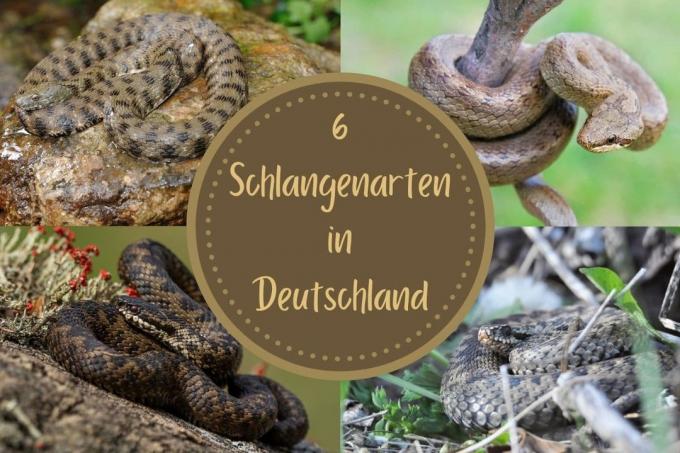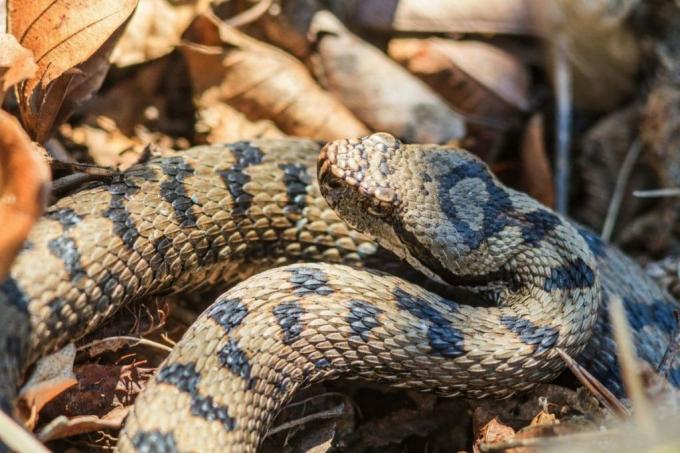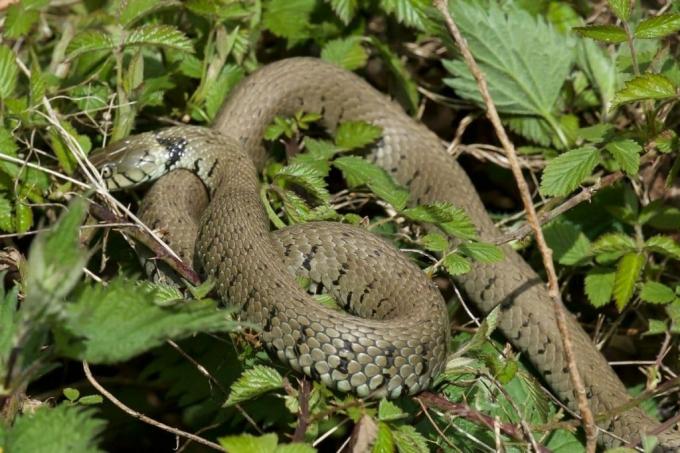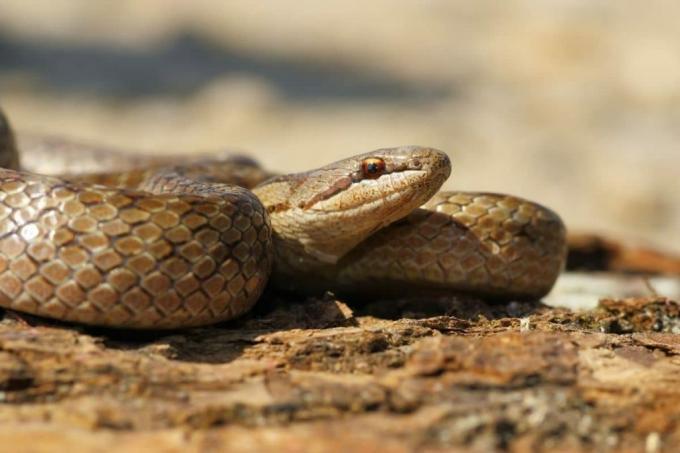
table of contents
- Aesculapian snake (Elaphe longissima)
- Aspis viper (Vipera aspis)
- Adder (Vipera berus)
- Grass snake (Natrix natrix)
- Smooth snake (Coronella austriaca)
- Dice snake (Natrix tessellata)
- frequently asked Questions
Do you think snakes only live in distant lands? No, even in Germany you can come across a specimen of the native snake species on your hike. We introduce you to six types.
In a nutshell
- Snakes are very rare in Germany
- most of the species are non-toxic
- all domestic snakes are strictly protected
- The reason for the disappearance is the decrease in habitat
- 3000 species worldwide, only six species in Germany
Aesculapian snake (Elaphe longissima)
Everyone knows the Aesculapian snake. She is the symbol of the medical profession. The non-poisonous snake is one of the largest Central European snake species. Individual specimens reach a length of two meters. Aesculapian snakes can live up to thirty years.

- Length: 150 to 180 centimeters
- Head: narrow head, eyes with round pupils
- Characteristics: top light brown, underside light, darkening from head to tail, scales with fine white lines, partly yellow spots on both sides of the back of the head
- Mating: May to June, 5 to 8 eggs
- Offspring: July to August
- Occurrence: a few specimens in the Rheingau, Odenwald, Taunus
- Habitat: vineyards, deciduous forests, bushy quarries
- Food: mice, moles, birds
Note: The juveniles of the Aesculapian snake are very strikingly colored. They have bright yellow neck rings and consistently dark spots on the light brown back color.
Aspis viper (Vipera aspis)
The aspis viper lives in sunny, rocky biotopes. Their venom is stronger than that of the adder.

- Length: 60 to 70 centimeters
- Head: broad, triangular head, eyes with vertical slit-shaped pupil, yellowish iris
- Characteristics: gray to gray-brown, male animals have more contrast than female, dark transverse bands, flanks with dark, rectangular spots
- Mating: April to May, frequent comment fights
- Offspring: October, 4 to 16 young animals
- Occurrence: few occurrences in the southern Black Forest
- Habitat: very warm and sunny biotopes, rocky, with many hiding spots
- Diet: lizards, small mammals
Note: Aspisvipers can live to be twenty years of age.
Adder (Vipera berus)
The adder is one of the very rare species of snake in Germany. She is very shy. Adders are poisonous and their bite is rarely fatal.

- Length: 60 to 80 centimeters
- Head: elongated head, eyes with vertical slit-shaped pupil, reddish iris
- Characteristics: male animals gray to gray-brown, slender, female animals yellow-brown to dark brown, longer and plump, dark zigzag band on the back, flanks with dark spots
- Mating: April to May, frequent comment fights
- Offspring: September to October, 4 to 18 young animals
- Occurrence: Southern Germany, Northern Germany
- Habitat: humid biotopes with lots of hiding spots and sunny spots
- Food: lizards, mice
Grass snake (Natrix natrix)
Grass snakes live in water and on land (semi-aquatic). Grass snakes can play dead in dangerous situations.

- Length: 70 to 85 centimeters
- Head: narrow head, eyes with round pupils, nostril directed upwards
- Characteristics: blue-gray to greenish, more rarely brown or black, underside white with a cube pattern, yellow crescent-shaped spots on the back of the head,
- Mating: April to May, 10 to 40 eggs
- Offspring: July
- Occurrence: mainly in western parts of Germany
- Habitat: Biotopes with dry, sunny spots and small bodies of water
- Food: amphibians and small rodents
Note: Grass snakes used to be a symbol of luck. It was thought that they had the ability to ward off disease. Farmers put a bowl of milk for them at night to please them. The cats were probably especially happy about that.
Smooth snake (Coronella austriaca)
Smooth snakes are also known as smooth snakes or hazel snakes. They are smaller than other types of snakes and very inconspicuous. This species of snake is very rare in Germany and particularly threatened with extinction.

- Length: 60 centimeters
- Head: small, flat head, pointed snout, eyes with round pupils, smooth scaling
- Characteristics: basic color brown to gray, noticeable dark spot on the neck, dark stripes on the cheeks
- Mating: May, viviparous
- Offspring: August, 10 to 15 young
- Occurrence: Southern Germany
- Habitat: southern slopes with dry, sunny spots on stone slabs
- Food: Lizards, Mice
Note: The smooth snake is often confused with the adder. However, the little snake is completely non-toxic.
Dice snake (Natrix tessellata)
The dice snakes native to Germany are water snakes. Due to the increasing pollution of the waters, this species is threatened with extinction.

- Length: 70 to 90 centimeters
- Head: narrower, more elongated head, eyes with round pupils, nostril directed upwards
- Features: basic color gray-brown, clear cube pattern on the top, V-shaped spot on the neck
- Mating: April to June, 5 to 25 eggs
- Offspring: July to August
- Occurrence: a few specimens on the Moselle, Lahn and Nahe
- Habitat: Shores of fish-rich flowing waters
- Food: fish
frequently asked Questions
When a person is bitten by a venomous snake like the aspic viper, it is important to keep calm. Disinfect the bite wound. Put on a stowage bandage. Take the person to the doctor. The bitten person should be driven or carried, only allowed to walk in an emergency. The wound must not be sucked out or cut open.
If you come across a snake in the forest or in the garden, stay calm. Under no circumstances should you try to catch the snake. This is strictly forbidden and not without risk with the poisonous adders and aspisvipers.
Avoid chemicals in your garden. Leave some piles of leaves and brushwood so that snakes can find shelter. If you spot a snake in the garden, be happy about it. Snakes can only be found in habitats with a good ecological structure.



